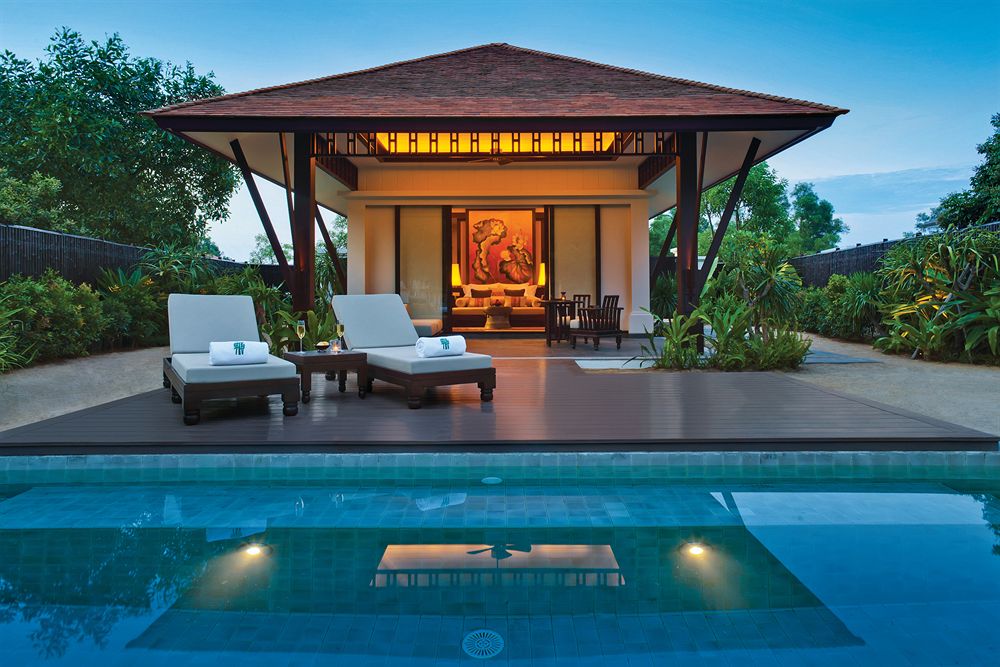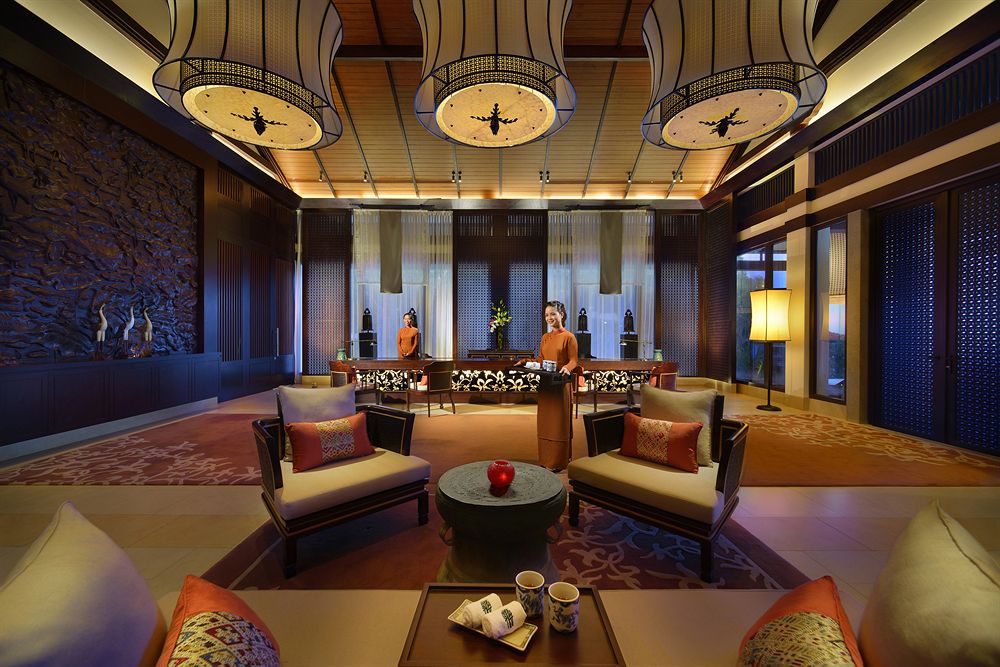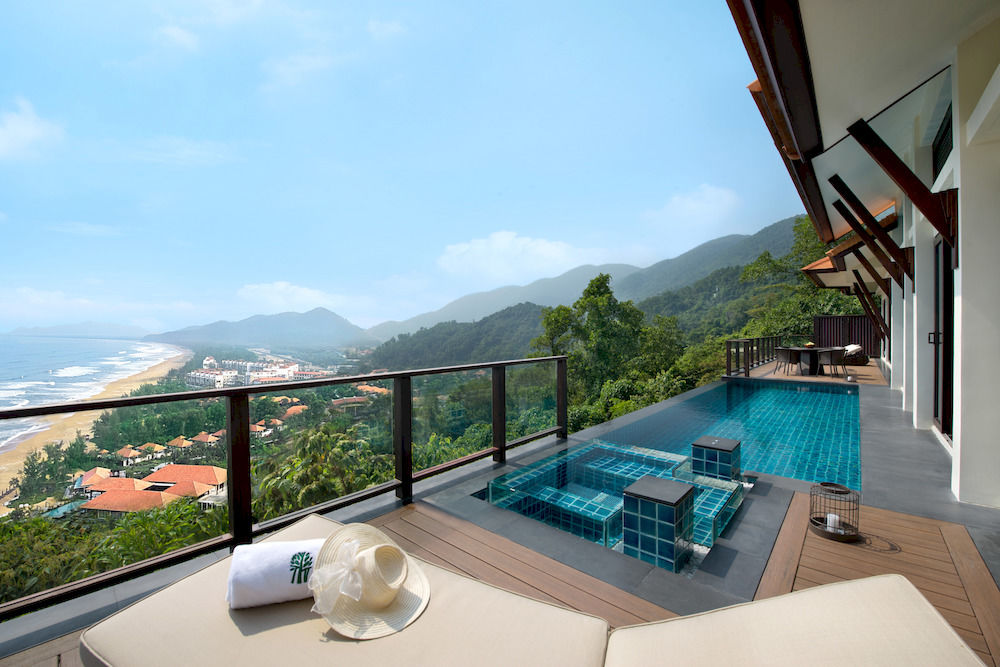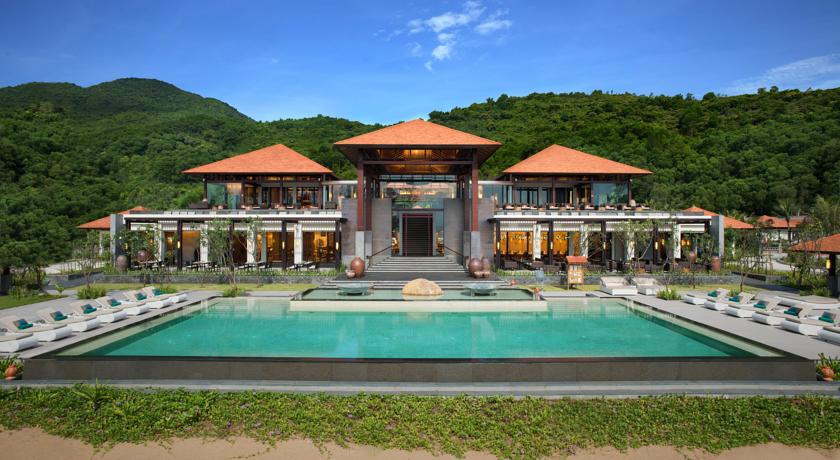




Banyan Tree Lang Co Resort
We are sorry, there are no rooms available at this accommodation at the moment
General
Description:
Enter a world steeped in deep-rooted history, dramatic vistas spread across a rugged landscape, unspoiled nature and UNESCO World Heritage Sites. Explore the beauty and charm of Lang Co. In Central Vietnam, Banyan Tree Lang Co is an all-pool villa resort. Feel the warm waves of the East Sea tickle your toes, and raise your gaze to behold the magnificent stretch of the Truong Son Mountain Range. Within touch of three UNESCO World Heritage Sites – the imperial city of Hue, charming old town of Hoi An and My Son’s historical ruins – culture aficionados will be satiated. Those with a bent for the physical will also find joy in a wide range activities. Golfers can tee off in style at the Sir Nick Faldo-designed 18-hour championship golf course, meandering through rice paddies and trickling streams against the backdrop of a staggering mountain range.
Location:
Located in the tranquil southern coast of Vietnam near Lang Cô Bay, retreat to this intimate collection of stunning pool villas in Banyan Tree Lang Cô, Central Vietnam. Step into opulent villas reminiscent of past Vietnamese dynasties complete with sophisticated modern amenities.
Surrounded by eco-diverse mountains, spectacular national parks and awe-inspiring UNESCO World Heritage Sites, explore the cultural riches of Indochina, relax on the private golden beach or indulge yourself in a time-honoured Asian spa treatment.
Reservation Policy:
Check-in: From 15:00 hours
Check-out: Until 12:00 hours
Breakfast fee for child from 4 to 12 years old is VND 430,000 per nett per child. This breakfast fee for child is charged when child is sharing bed with parents.
Guests visiting Vietnam for tourist and business travels requires a visa prior to arrival.
Room type
One-Bedroom Beach Villa with Private Pool
Two-Bedroom Hillside Pool Villa with Ocean View
One-Bedroom Lagoon Villa with Private Pool – Special Offer
Three-Bedroom Hillside Pool Villa with Ocean View
Hillside Pool Villa with Ocean View
One-Bedroom Beach Villa with Private Pool – Special Offer
One-Bedroom Lagoon Villa with Private Pool
Check-in
14:00
Check-out
12:00
Cancellation / Prepayment
Children and extra beds
Facilities & Services
- Air Conditioning
- Airport Shuttle Service
- Bath
- Bathroom
- Beachfront
- Car hire
- Catering services
- Complimentary breakfast
- Courtyard
- Desk
- Exhibition/convention floor
- Hairdryer
- Heating
- Hotspots
- Ironing board
- Ironing Facilities
- Kitchenette
- Laundry/Valet service
- Lounges/bars
- Pay-per-view Channels
- Restaurant
- Room service - full menu
- Safety Deposit Box
- Seating Area
- Shower
- Telephone
- Television
- Toilet
- Valet cleaning
- WIFI
Hue - The Land of Kings and Emperors

Located on the bank of Song Huong- Perfume River; Hue, the capital of Thua Thien Hue province in Central Vietnam, is 700 km southern Hanoi, 1100km northern Ho Chi Minh City, and only a few miles from the sea. Not until 1945 was Hue the national capital, the political, cultural and religious center of Vietnam under the control of Nguyen Dynasty.
Palaces and pagodas, tombs and temples, culture and cuisine, history and heartbreak – there’s no shortage of poetic pairings to describe Hue. A Unesco World Heritage site, this deeply evocative capital of the Nguyen emperors still resonates with the glories of imperial Vietnam, even though many of its finest buildings were destroyed during the American War.
Hue owes its charm partly to its location on the Perfume River – picturesque on a clear day, atmospheric even in less flattering weather. There’s always restoration work going on to recover Hue’s royal splendor, but today the city is very much a blend of new and old as sleek modern hotels tower over crumbling century-old Citadel walls.
The city hosts a huge biennial arts festival, the Festival of Hue, in even-numbered years, featuring local and international artists and performers. Journalist Gavin Young’s 1997 memoir A Wavering Grace is a moving account of his 30-year relationship with a family from Hue and with the city itself, during and beyond the American War. It makes a good literary companion for a stay in the city.
When the best time to visit Hue
From March to August will be the best time to visit Hue, especially between March and April when the temperature is more pleasant, though rainfalls are still likely. Hue sees fog and rain quite frequently, even when the weather across the Hai Van Pass in nearby Danang is sunny. During the rainy season, between September and January, rain is more frequent and can be heavy.
Getting There & Away
Air
Hue’s Phu Bai airport is about 15 kilometers from Hue city Centre and presently only serves domestic flights between HCMC and Hanoi. Taxi fares from airport to city are approximately 250,000 VND and a motorbike taxi should be around 120,000 VND. The airport also offers a bus service to cover the route and you can book this at the airport for 45,000 VND although it’s not always running.
Bus
– The main bus station, 4km southeast, has connections to Danang and south to Ho Chi Minh City.
– An Hoa bus station (Highway 1), northwest of the Citadel, serves northern destinations, including Dong Ha (50,000d, 2 hours, every half hour).
– Hue is a regular stop on open – tour bus routes. Most drop off and pick up passengers at central Hue hotels. Expect some hassle from persistent hotel touts when you arrive.
Please contact us to book ticket.
Train
Hue is an express stop on the main north-south train line between Hanoi and Ho Chi Minh City. The train station is located at the eastern end of Le Loi Road, on the south bank of the Ben Ngu River.
All of these tickets can be booked at the station or at our office.
Taxi
Taxis are everywhere in Hue, although there are a few that will take you on a rather scenic tour if you don’t know the area. To avoid this look out for the Green Mai Linh or yellow Taxi Vang, both of which have meters starting at 12,000d and charging 11,000d per kilometer – expect to pay 35,000d from the train station to Pham Ngu Lam.
Mai Linh Taxi: (54) 839 8989
Taxi Vang: (54) 379 7979
Cyclo & Motorbike taxis (Xe om)
Cyclos and motorbike taxis are the way to go. Unless you can make yourself invisible, they’ll find you before you find them! Drivers will charge what they think they can get, so you’ll have to come up with whatever price you think is reasonable. Our rule of thumb is 8,000d for every kilometer on a motorcycle taxi on short trips, less for longer trips, and again about 100,000d for an entire hour by cyclo.
Sights & Activities
Imperial City of Hue
hough much of the land within the Citadel these days is wasteland, first impressions for visitors don’t disappoint, as the first sight approaching the Noon Gate (Ngo Mon Gate) is of massive walls, seven metres high and 20 metres thick, protecting the enclave.
The walls run almost 10kms and are surrounded by a moat and canal, offering extra protection to what appears an impenetrable defence. Just near this gate is the city’s Flag Tower, a 37-metre high flag pole set on three squat terraces, and the square here is surrounded by nine sacred cannons.
Work to reconstruct the Imperial City is ongoing, but buildings that have been reconstructed and are open to the public include the Thai Hoa Palace, the Mieu Complex and the Thai Binh Reading Room. The Thai Hoa Palace is where emperors would have received visiting guests, and the original throne still stands here.
Another sight that intrigues most visitors lies in the southwest corner of the enclosure – the Nine Dynastic Urns, each weighing around 2,000kgs and dedicated to one of the Nguyen lords who ruled the city. Made of bronze, they are adorned with animals and plants and are considered to be supreme examples of Hue craftsmanship.
Imperial Mausoleums of Hue
There are seven of these mausoleums scattered around the hills near Hue, but each one is so vast that it makes sense to select just a couple to visit rather than try to see them all. Though all follow the same basic principle, containing a tomb and a temple surrounded by landscaped gardens, the style of each emperor is quite different and reflects their character. Two of the most-visited are Tu Duc and Minh Mang, for which an entrance fee of 55,000D each is charged, but are well worth it for their intricate decorations and inspired landscaping.
Ho Chi Minh Museum
Every town’s got one, but this Ho museum is better than most. The father of the modern Vietnamese nation spent 10 years in Hue, and you’ll find some intriguing photographs with English caption.
National School
One of the most famous secondary schools in Vietnam, the National School was founded in 1896. Many of its pupils later rose to prominence: General Vo Nguyen Giap, strategist of the Viet Minh victory at Dien Bien Phu; Pham Van Dong, former prime minister of North Vietnam; and Ho Chi Minh (who attended for a year in 1908).
The school admits students aged 16 to 18, but entrance examinations are notoriously difficult. You can visit the school during lunch break and after classes finish.
Eating & Drinking
In Hue, the dishes were specially created for the Kings. And if they weren’t, they sure were variations on those royal creations by commoners outside the Citadel. The method of cooking, the plating and presentation are reminiscent of the aristocratic time long gone. The most popular dishes are Bun Bo Hue (Hue beef vermicelli), Pho bo (beef noodle soup), Banh Khoai (pan cake), Banh Nam and curiously, sesame candy.
The best place to try them in town is the Bun Bo Hue at 17 Ly Thuong Kiet Street, located just a block south of Hanoi St. The food, served in a refreshingly unpretentious restaurant, is delicious and cheap.
If you’re looking for a vegetarian cuisine and vegan cuisine, the best places to find them are the riverside and alleys in the city. Com chay or vegetarian food in Hue is a popular dish for local Buddhists and monks alike.
The Tinh Tam Restaurant at 24 Chu Van An Street serves delicious meals that taste like meat, such as grilled dishes with fake deer meat, cakes with fake shrimp and many others. You’ll also find similar establishments in streets most visited by travelers like the Dien Thien Hoang Street and Tran Hung Dao Street, situated north of the river very near the Citadel walls.
Do try eating at Lac Thien at 6 Dinh Tien Hoang Street also, where you’ll find banh khoai, a shrimp pancake and nem lui tom, a delicious shrimp salad. Because Vietnam is a Buddhist country, you’ll find lots of restaurants serving vegetable dishes.
There aren’t many bars and pubs, though, so if you’re looking for a hard night of drinking, the best alternative you have is the DMZ Bar. Besides beer, wines and cocktails, they have locally brewed Hue beers, Huda beers as well as beers used during festivals.
Read more
